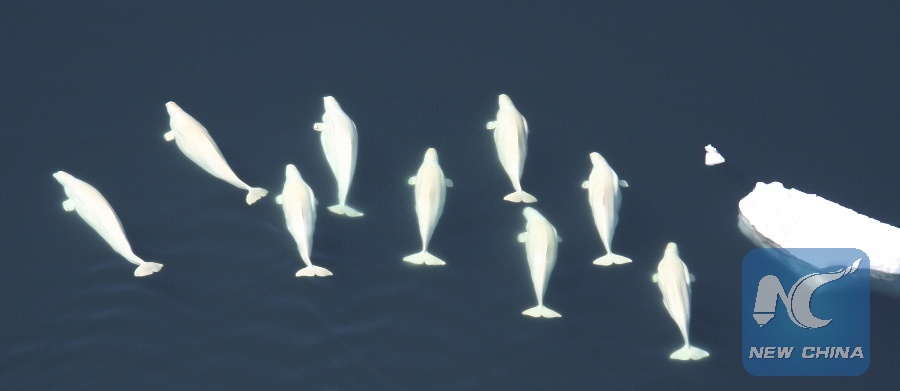
File Photo: Beluga whales are shown in the Chukchi Sea near Alaska in this July 1, 2008 photo from the National Oceanic and Atmospheric Administration National Marine Mammal Laboratory. The NOAA said it has determined that belugas in Cook Inlet, the channel that flows from the Anchorage area to the Gulf of Alaska, are at risk of extinction and deserving of strict protections under the Endangered Species Act. (Xinhua/REUTERS)
SAN FRANCISCO, June 14 (Xinhua) -- The endangered Cook Inlet white whales have significantly changed their diet from ocean-like prey to more of freshwater feeding over the past 50 years, a new study shows.
Researchers from the University of Alaska Fairbanks (UAF) in the U.S. northwest state of Alaska used isotope analysis to identify the food sources for Cook Inlet belugas since the 1950s.
By studying isotope signatures from beluga skulls and growth layers in teeth, the researchers found that the marine mammals seem to have shifted to more freshwater-influenced feeding as their range gradually contracted, said the study, which was published Wednesday in the journal Endangered Species Research.
"Figuring out what started to drive belugas toward freshwater environments and away from the marine environments might be key in figuring out why they haven't recovered," said Mark Nelson, the lead author of the study.
The white whales are spending more time in the upper reaches of Cook Inlet, and it's showing in their diet, Nelson said.
The findings came after the UAF researchers analyzed samples of 20 beluga skulls at the University of Alaska Museum of the North, along with analysis of tooth growth layers from 26 belugas provided by the museum and the Alaska Department of Fish and Game.
The study presents the first evidence for a long-term change in the feeding ecology of Cook Inlet belugas.
Cook Inlet belugas were listed as endangered under the U.S. Endangered Species Act in 2008, and have a current population of about 340 animals, far below the 1,300 belugas that scientists say swam in the silty water between Anchorage and the Gulf of Alaska as recently as the 1970s.
"There's been a change in where they're feeding and what they're feeding on," Nelson said, adding that belugas have not only declined in numbers, but also contracted their range.
Nelson said the study of the teeth and bone samples of belugas collected from the 1950s to 2007 revealed a shift in their diet toward freshwater-influenced feedings beginning as early as the 1950s.
The change steadily continued through the decades, with the whales' diet consisting more and more of freshwater prey, he said.
The results of the study will help in the conservation of the endangered species of white whales in Cook Inlet in the Gulf of Alaska.

